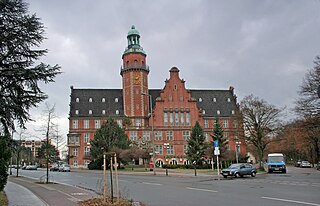
Fritz Todt was a German construction engineer, senior Nazi, who rose from "Inspector General for German Roadways" where he directed the construction of German Autobahnen (Reichsautobahnen) to Reich Minister for Armaments and Ammunition where he directed the entire war military economy. At the beginning of World War II he initiated what Hitler named Organisation Todt, a military engineering company which supplied industry with forced labor and administered all constructions of concentration camps in the late phase of the Third Reich. He died in a mysterious airplane crash in 1942.

Emmendingen is a town in Baden-Württemberg, capital of the district Emmendingen of Germany. It is located at the Elz River, 14 km (8.7 mi) north of Freiburg im Breisgau. The town contains more than 26,000 residents, which is the most in the Emmendingen district.

Halle, officially Halle (Westf.) or Halle Westfalen to distinguish it from the larger Halle (Saale), is a town in the German Bundesland of North Rhine-Westphalia, 15 km west of Bielefeld, and belongs to the district of Gütersloh in the region of Detmold.

Versmold or Vassem in Westphalian Platt is a town in Gütersloh District in the German state of North Rhine-Westphalia. It is located some 30 km west of Bielefeld.

Lübbecke is a town in northeast North Rhine-Westphalia in north Germany. This former county town lies on the northern slopes of the Wiehen Hills (Wiehengebirge) and has around 26,000 inhabitants. The town is in the Eastwestphalian district of Minden-Lübbecke. Lübbecke was first mentioned in the records in 775 as hlidbeki and was given town rights in 1279.
Deizisau is a town in the district of Esslingen in Baden-Württemberg in southern Germany. It belongs to the Stuttgart Region (until 1992 Region Mittlerer Neckar) and the Stuttgart Metropolitan Region. Deizisau is located between the towns of Plochingen and Esslingen am Neckar, about 20 kilometers southeast of Stuttgart, the capital of Baden-Württemberg. The river Neckar flows through this town.

Steinfeld is a community in the Main-Spessart district in the Regierungsbezirk of Lower Franconia (Unterfranken) in Bavaria, Germany and a member of the Verwaltungsgemeinschaft of Lohr am Main.

Fahrenwalde is a municipality in the district Vorpommern-Greifswald in the east of the German federal state Mecklenburg-Vorpommern. It is administrated by the Amt Uecker-Randow-Tal, which is based in Pasewalk.

The village of Dorfmark is part of the borough of Bad Fallingbostel in Heidekreis district in the German state of Lower Saxony.

Barbara Aland, née Ehlers is a German theologian and was a Professor of New Testament Research and Church History at Westphalian Wilhelms-University of Münster until 2002.

Wittenau (help·info) is a German locality (Ortsteil) within the borough (Bezirk) of Reinickendorf, Berlin.

The Francke Foundations, also known as Glauchasche Anstalten in Halle, were founded in 1695 as a Christian, social and educational work by August Hermann Francke (1663–1727), a Pietist, theologian and university professor in Halle, Germany. Francke Foundations are today a modern educational cosmos closely connected with their history. The Francke Foundations are on the German proposal list as a UNESCO World Heritage Site since 1999.

Lothar Mohn is a German church musician.

Drüber is a southern suburb of the city of Einbeck, district Northeim. It has 494 inhabitants, of which 259 are male, and 235 female.

Saaleck Castle is a hill castle near Bad Kösen, now a part of Naumburg, Saxony-Anhalt, Germany.
Bettina Baumgärtel is a German art historian who is head of the painting collection of the Museum Kunstpalast in Düsseldorf. She is a leading authority on the art of Angelica Kauffman and founded the Angelika Kauffmann Research Project (AKRP), of which she is the director, in 1990.

Vierlande is the name given to a roughly 77-square kilometre region in the Hamburg district of Bergedorf which has a population of 18,419  and comprises four quarters of the city.
















